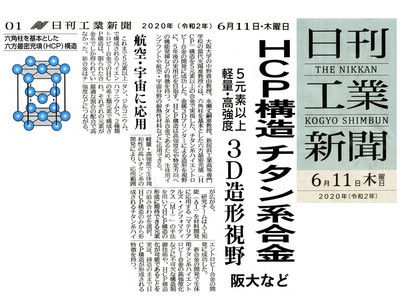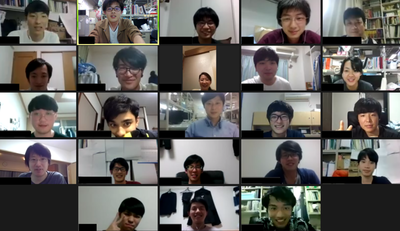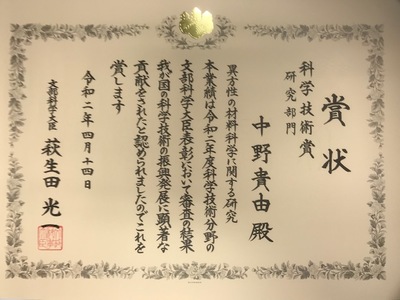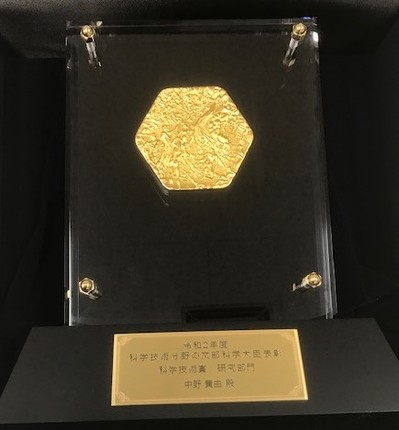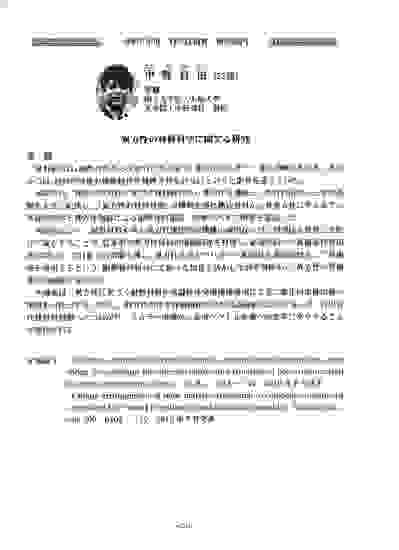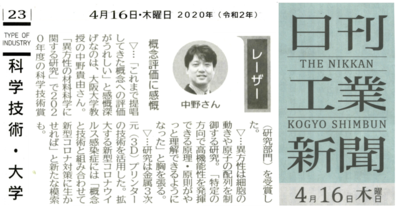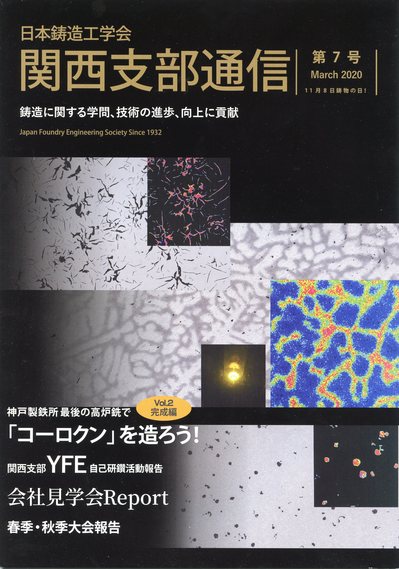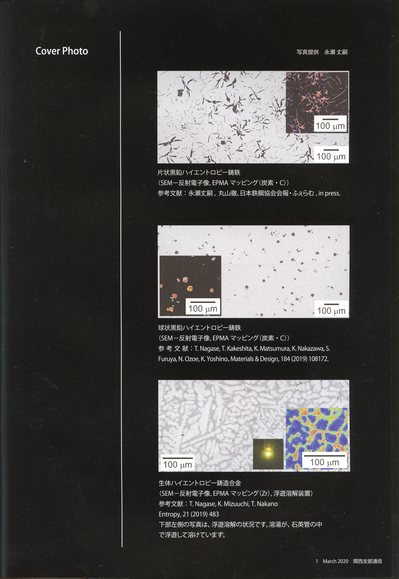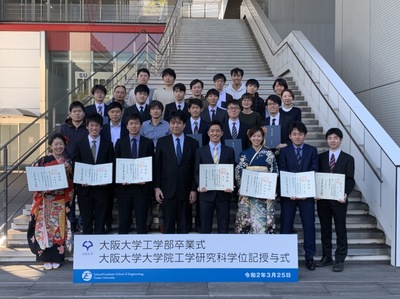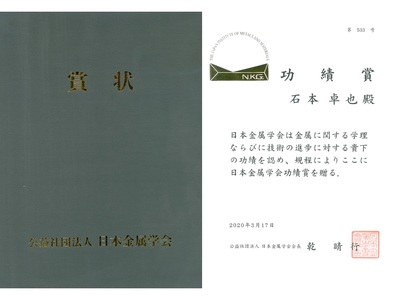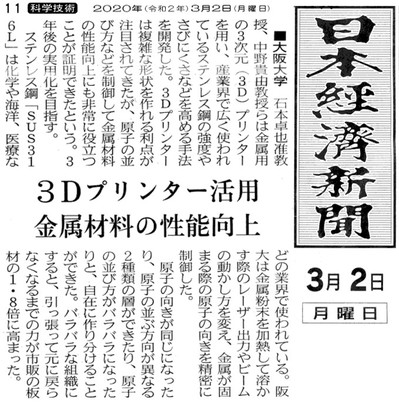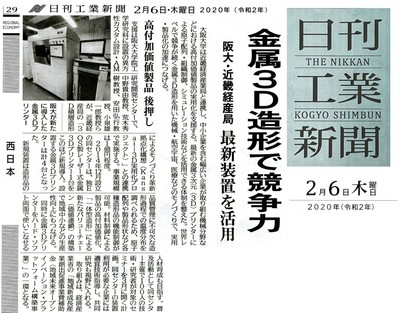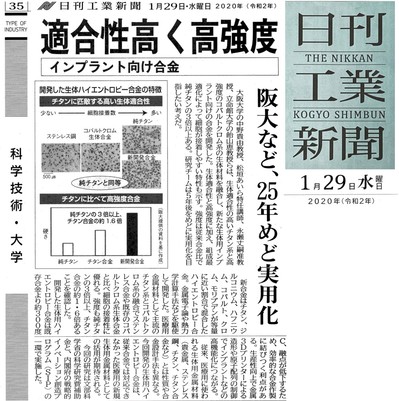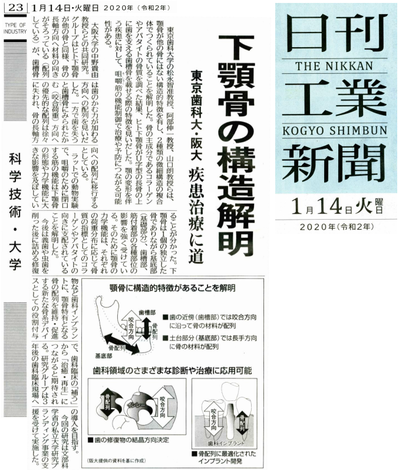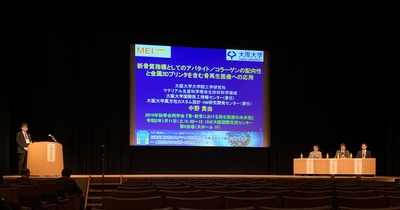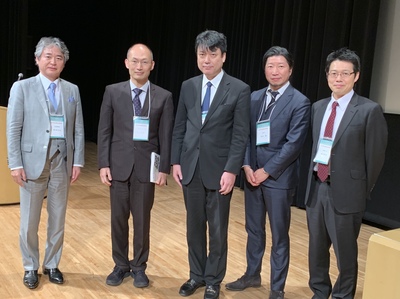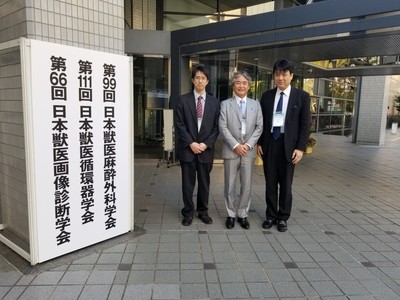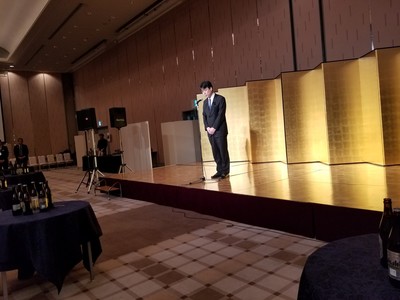What's New
2020(January-June)
-
2020.6.25
-
2020.6.20
-
2020.6.20
-
2020.6.20
-
2020.6.11
-
2020.6.10
-
2020.6.5
-
2020.5.29
-
2020.5.28
-
2020.5.25
-
2020.5.21
-
2020.5.20
-
2020.5.20
-
2020.5.18
-
2020.5.13
-
2020.5.13
-
2020.5.9
-
2020.5.7
-
2020.4.27
-
2020.4.24
-
2020.4.24
-
2020.4.16
-
2020.4.13
-
2020.4.13
-
2020.4.10
-
2020.4.8
-
2020.4.2
-
2020.4.1
-
2020.4.1
-
2020.4.1
-
2020.3.25
-
2020.3.24
-
2020.3.23
-
2020.3.23
-
2020.3.20
-
2020.3.17
-
2020.3.14
-
2020.3.11
-
2020.3.2
-
2020.2.27
-
2020.2.9
-
2020.2.6
-
2020.2.4
-
2020.1.31
-
2020.1.29
-
2020.1.21
-
2020.1.14
-
2020.1.14
-
2020.1.11
-
2020.6.25
The Biomaterials Subcommittee of the Committee on Materials Science and Engineering of the Science Council of Japan (Chairman: Prof. Kazunori Kataoka) has issued a proposal, "Construction of International Leading Research Center for Biomaterials" as the "
-
2020.6.20
A research of the two-phase separation of new BioHEAs (biological high entropy alloys) has been published in MDPI's "Crystals" as open access.
Takeshi Nagase, Mitsuharu Todai, Takayoshi Nakano*:
Liquid Phase Separation in Ag-Co-Cr-Fe-Mn-Ni, Co Cr-Cu-Fe-Mn-Ni and Co-Cr-Cu-Fe-Mn-Ni-B High Entropy Alloys for Biomedical Application,
Crystals, 10(6), (2020), 527; 1-20.
https://doi.org/10.3390/cryst10060527
Click here for this paper.
Click here for this PDF.Abstract
The liquid phase separation (LPS) behavior in Co-Cr-based high-entropy alloys (HEAs) is an important target for the development of Co-Cr-based HEAs for metallic biomaterials (BioHEAs). The solidification microstructure in Ag-Co-Cr-Fe-Mn-Ni-Ag, Co-Cr-Cu-Fe-Mn-Ni-Cu, and Co-Cr-Cu-Fe-Mn-Ni-B HEAs, which were designed as the combination of the equiatomic CoCrFeMnNi with Ag, Cu, and the interstitial element of B, was investigated as the fundamental research of LPS in Co-Cr-based HEAs. Ingots of equiatomic AgCoCrFeMnNi, equiatomic CoCrCuFeMnNi, non-equiatomic CoCrCuxFeMnNi (x = 2, 3), and CoCrCuxFeMnNiB0.2 (x = 1, 2, 3) with a small amount of B were fabricated using the arc-melting process. A macroscopic phase-separated structure was observed in the ingots of the equiatomic AgCoCrFeMnNi and CoCrCuxFeMnNiB0.2 (x = 2, 3) HEAs. The addition of a small amount of B enhanced the LPS tendency in the Co-Cr-Fe-Mn-Ni-Cu HEAs. The LPS behavior was discussed through the heat of mixing and computer coupling of phase diagrams and thermochemistry (CALPHAD).Keywords: high-entropy alloys; metallic biomaterials; BioHEAs; liquid phase separation; solidification; microstructure; CALPHAD
-
2020.6.20
Nakano lab's commentary on bone matrix orientation was published in the July issue of BIO Clinica.
-
2020.6.20
Nakano Lab members participated in the 40th Annual Meeting of the Japanese Society For Bone Morphometry (paper version).
Dr. Nakano gave a symposium lecture.
The presentations are as followsSymposium Lecture
Nakano Takayoshi
Bony Site-Dependent Bone Substrate Orientation and Bone Implant AlignmentOral Presentation
○Ishimoto Takuya, Kawahara Keita, Matsugaki Aira, Ueoka Hiroshi, Nakano Takayoshi
Correlation between apatite orientation and osteocyte morphological anisotropy, in longitudinal bone○Matsugaki Aira, Nakanishi Yohei, Nakano Takayoshi
Specific Orthogonal Bone Substrate Orientation by Nanoperiodic Surface Structures○Ozasa Ryosuke, Sasaki Kyohei, Nakano Takayoshi
Changes in Bone Substrate Orientation and Young's Modulus in Atherosclerosis○ Matsuzaka Tadaaki, Matsugaki Aila, Nakano Takayoshi
Elucidation of the mechanism of osteocyte-derived bone substrate orientation by constructing a stress-loaded anisotropic co-culture model○Yamaoka Yusuke, Ozasa Ryosuke, Nakano Takayoshi
Bone Substrate Orientation and Altered Bone Strength in X-Chromose-Linked Hypolymphemic Rickets -
2020.6.11
The hcp-Ti-based HEA developed at Nakano Lab was featured on the front page of Nikkan Kogyo Shimbun.
-
2020.6.10
Matsuzaka Tadaaki(M1) was selected for the 40th Young Researcher Award of the Japanese Society For Bone Morphometry.
Matsuzaka Tadaaki:
Elucidation of osteocyte-initiated bone substrate orientation in a stress-loaded anisotropic co-culture model
(Co-researchers: Matsugaki Aira and Nakano Takayoshi) -
2020.6.5
A paper on a high entropy alloy containing two anisotropic hcp structures developed at Nakano Laboratory has been published online as an open access article in Scripta Material.
Takeshi Nagase, Mitsuharu Todai, Takayoshi Nakano*:
Development of Ti–Zr–Hf–Y–La high-entropy alloys with dual hexagonal-close-packed structure,
Scripta Materialia, 186 (2020), pp.242-246.
Click here for this paper.Highlights
•Ti–Zr–Hf–Y–La high-entropy alloys with dual hcp structure were developed.
•Ti–Zr–Hf-rich and Y-La-rich phases were formed.
•Equi-axis dendrite structure was observed in the central area of the ingot.
•Liquid phase separation and segregation formed the dual hcp structure.
•The alloy design was verified based on immiscibility.Abstract
TiZrHfYLa0.2 high-entropy alloys (HEAs) with dual hexagonal-closed-packed (HCP) structures were designed based on the concept of liquid phase separation (LPS) and segregation for enhancing the immiscibility of the constituent elements. The LPS leads to a particular solidification microstructure on the free surface side and Cu-hearth contacted area in the ingots. The dual HCP structures with equi-axis Ti–Zr–Hf dendrite and Y-La-rich interdendrite were observed at most regions of the arc-melted ingots. The mixing enthalpy among the constituent elements and predicted phase diagrams constructed by the Materials Project were effective for the alloy design of the HEAs with dual HCP structures. -
2020.5.29
The book "Development of Materials for 3D Printer and High Precision Modeling" was published by Gijyutsu Jyoho Kyokai Co.
Ozasa Ryosuke, Ishimoto Takuya, Nakano Takayoshi:
Development of functional additive manufacturing materials based on crystal orientation control by metal 3D printer, "Development of Materials for 3D Printer and High Precision of Fabrications,
Technical Information Association, (2020), pp. 445-454.
click here for more information -
2020.5.28
A research revealing for the first time that osteocalcin (OCN) determines the c-axis orientation of apatite crystals to collagen fibers, in collaboration with Dr. Komori and others at Nagasaki University, has been published as open access in PLoS Getetics
Takeshi Moriishi, Ryosuke Ozasa, Takuya Ishimoto, Takayoshi Nakano, Tomoka Hasegawa, Toshihiro Miyazaki, Wenguang Liu, Ryo Fukuyama, Yuying Wang, Hisato Komori, Xin Qin, Norio Amizuka, Toshihisa Komori*:
Osteocalcin is necessary for the alignment of apatite crystallites, but not glucose metabolism, testosterone synthesis, or muscle mass,
PLoS Getetics, 16 [5], (2020), e1008586.
https://doi.org/10.1371/ journal.pgen.1008586
Click here for this paper
Click here for this PDFAbstract
The strength of bone depends on bone quantity and quality. Osteocalcin (Ocn) is the most abundant noncollagenous protein in bone and is produced by osteoblasts. It has been previously claimed that Ocn inhibits bone formation and also functions as a hormone to regulate insulin secretion in the pancreas, testosterone synthesis in the testes, and muscle mass. We generated Ocn-deficient (Ocn–/–) mice by deleting Bglap and Bglap2. Analysis of Ocn–/–mice revealed that Ocn is not involved in the regulation of bone quantity, glucose metabolism, testosterone synthesis, or muscle mass. The orientation degree of collagen fibrils and size of biological apatite (BAp) crystallites in the c-axis were normal in the Ocn–/–bone. However, the crystallographic orientation of the BAp c-axis, which is normally parallel to collagen fibrils, was severely disrupted, resulting in reduced bone strength. These results demonstrate that Ocn is required for bone quality and strength by adjusting the alignment of BAp crystallites parallel to collagen fibrils; but it does not function as a hormone. -
2020.5.25
The paper on JBMR(Journal of Bone and Mineral Research) about Bone Quality published in 2013 is open-access.
Takuya Ishimoto, Takayoshi Nakano*, Yukichi Umakoshi, Masaya Yamamoto, Yasuhiko Tabata:
Degree of Biological Apatite c-Axis Orientation Rather Than Bone Mineral Density Controls Mechanical Function in Bone Regenerated Using Recombinant Bone Morphogenetic Protein-2,
Journal of Bone and Mineral Research (JBMR), 28 [5], (2013), pp 1170–1179.
DOI: 10.1002/jbmr.1825
Click here for this paper.
Click here for this PDF.ABSTRACT
The aim of the present study was to assess the bone regeneration process in defects introduced into rabbit long bones, which were regenerated with controlled release of recombinant bone morphogenetic protein-2 (rBMP-2). The orientation of the biological apatite (BAp) c-axis and bone mineral density (BMD) were compared as predictors of bone mechanical function. A 20-mm-long defect was introduced in rabbit ulnas, and 17 mg of rBMP-2 was controlled-released into the defect using a biodegradable gelatin hydrogel as the carrier. In the bone regeneration process, two characteristic phases may have been governed by different factors. First, new bone formation actively occurred, filling the bone defect with newly formed bone tissue and increasing the BMD. This process was regulated by the strong osteoinductive capacity of rBMP-2. Second, after filling of the defect and moderate BMD restoration, preferential BAp c-axis orientation began to increase, coincident with initiation of remodeling. In addition, the BAp c-axis orientation, rather than BMD, was strongly correlated with Young’s modulus, an important index of bone mechanical function, particularly in the later stage of bone regeneration. Thus, preferential BAp c-axis orientation is a strong determinant and predictor of the mechanical function of tissueengineered bone. Therefore, analysis of BAp preferential c-axis orientation in addition to measurement of BMD is crucial in assessment of bone mechanical function. Ⓒ2013 American Society for Bone and Mineral Research. -
2020.5.21
We had a B4 welcome party at zoom!
We had a welcome party for B4, who was assigned to us in April at zoom.
We still have a ban on B4's attendance at school, but we're looking forward to the day when the restrictions are lifted and he can come to our lab! -
2020.5.20
Prof. Tsutsumi published an article on "Improvement of Corrosion Resistance by Laser Additive Manufacturing" in Nikkan Kogyo Shimbun.
Stainless Steel - Expanding Applications by Demonstrating Corrosion Resistance: Stainless Steel
May 20, 2020, Nikkan Kogyo Shimbun morning edition, page 25 (Science and Technology, University)
Click here for this PDF -
2020.5.20
The Nakano Lab's paper was selected as one of the "Top Downloaded Papers 2018-2019" by the Journal of Biomedical Materials Research Part A (JBMR-A), published by Wiley.
The Nakano Lab's paper was selected as one of the "Top Downloaded Papers 2018-2019" by the Journal of Biomedical Materials Research Part A (JBMR-A), published by Wiley.
Click here for certificate. -
2020.5.18
Dr. Nakano received the Commendation and the medal for Awards for Science and Technology (Research Category) in 2020 by the Minister of Education, Culture, Sports, Science and Technology.
Nakano Takayoshi:
Research on materials science, anisotropic
Ministry of Education, Culture, Sports, Science and Technology, April 14, 2020Reasons for this award for "Research on Anisotropic Materials Science
Click here for the reasons
Click here for more information
Click here for the winners PDF
Click here for related articles on the Osaka University website -
2020.5.13
A collaborate research with Toyosawa Lab at Osaka University's Graduate School of Dentistry was published online in Bone.
Katsutoshi Hirose, Takuya Ishimoto, Yu Usami, Sunao Sato, Kaori Oya, Takayoshi Nakano, Toshihisa Komori, Satoru Toyosawa*:
Overexpression of Fam20C in osteoblast in vivo leads to increased cortical bone formation and osteoclastic bone resorption,
Bone, 138, (2020) 115414; 1-15
https://doi.org/10.1016/j.bone.2020.115414Click here for this paper
Abstract
Fam20C, which phosphorylates many secretory proteins with S-x-E/pS motifs, is highly expressed in bone and tooth tissues, implying that Fam20C-mediated phosphorylation is critical for regulation of these mineralized tissues. Previous studies of Fam20C-deficient mice revealed that Fam20C plays important roles in bone formation and mineralization. However, Fam20C-deficient mice develop hypophosphatemia, a systemic factor that masks the local effect of Fam20C in the bone tissue; consequently, the local role of Fam20C remains unknown. To elucidate the local function of Fam20C in bone tissue, we studied osteoblast-specific Fam20C transgenic (Fam20C-Tg) mice, which have no alteration in serum calcium and phosphate levels. Fam20C-Tg mice had more highly phosphorylated proteins in bone tissue than wild-type mice. In cortical bone of Fam20C-Tg mice, bone volume, mineralization surface (MS/BS), and mineral apposition rate (MAR) were elevated; in addition, the transgenic mice had an elevated number of vascular canals, resulting in an increased cortical porosity. Osteocyte number was elevated in the transgenics, but osteoblast number was unchanged. The microstructure of bone matrix characterized by the preferential orientation of collagen and apatite, was degraded and thus the mechanical function of bone material was deteriorated. In trabecular bone of Fam20C-Tg mice, bone volume was reduced, whereas MS/BS and MAR were unchanged. Osteoclast number was elevated and eroded surface area was non-significantly elevated with an increased serum CTX-I level, whereas osteoblast number was unchanged. These findings indicated that Fam20C overexpression in osteoblasts promotes cortical bone formation by increasing MS/BS and MAR and promoting osteocyte differentiation, but does not affect trabecular bone formation. Furthermore, Fam20C overexpression indirectly promotes osteoclastic bone resorption in cortical and trabecular bones. Our findings show that osteoblastic Fam20C-mediated phosphorylation in bone tissue regulates bone formation and resorption, and bone material quality. -
2020.5.13
An article by Kondo Haruka, who participate in the Nakano laboratory in the SEEDS program last year, was published in "Materia".
Kondo Haruka:
My Life-Changing Experience: Unraveling the Relationship between High Blood Pressure and Bone, by
Matelian, 59 [5], (2020), pp. 269.
Click here for this PDF -
2020.5.9
The article on "Development of Bone Formation Promoting Materials Using Bioactive Glasses" was published in Ceramics.
Sungho Lee, Toshihiro Kasuga and Takayoshi Nakano:
Development of osteopathic materials, using bioactive glasses to promote bone formation
Ceramics, 55 [3], (2020), pp. 150-154.Click here for this PDF
-
2020.5.7
A collaborate research paper with Northeast University and Shanghai University was published online as open-access in the Journal of Materials Engineering and Performance.
Qiang Li , Chao Cheng, Junjie Li, Ke Zhang, Kai Zhou, Masaaki Nakai, Mitsuo Niinomi, Kenta Yamanaka, Daixiu Wei, Akihiko Chiba, Takayoshi Nakano:
Low Young‛s Modulus and High Strength Obtained in Ti-Nb-Zr-Cr Alloys by Optimizing Zr Content,
Journal of Materials Engineering and Performance, (2020) on line.
https://doi.org/10.1007/s11665-020-04826-6 -
2020.4.27
A commentary and a paper on the Nakano Lab's research will be published in the July 2020 issue of the Journal of the Smart Process Society, respectively.
[Commentary]
Aira Matsugaki, Takayoshi Nakano:
Development of biomaterials and their application to cell regulation, using 3D printing
Journal of Smart Process Society, Vol. 9, [4], (July 2020), pp164-168
[Paper]
Ken Cho, Hiroyuki Yasuda*, Mitsuyo Toudai, Minoru Ueda, Masao Takeyama, Takayoshi Nakano:.
Improvement of high temperature fatigue properties of TiAl alloy fabricated by electron beam stacked fabrication by hot isostatic pressing, by
Journal of Smart Process Society, Vol. 9, [4], (July 2020), pp180-184 -
2020.4.24
An article on the collaborate research with Professor Matsumoto of Okayama University was published in Nikkan Kogyo Shimbun newspaper.
Titanium for Metal Adhesives, for Bio-soft Tissue, Okayama University, etc.
Nikkan Kogyo Shimbun morning edition, page 23, April 24, 2020 -
2020.4.24
The book "High Entropy Alloys," which Professor Nakano co-authored, will be published.
Takayoshi Nakano (Contributing Writer).
High entropy alloys, "Chapter 6.2 Biomaterials",
Uchida rokakuen, Tokyo, (2020).
Click here for more book details -
2020.4.16
An article about Prof. Nakano's award to the Minister of Education, Culture, Sports, Science and Technology appeared in the column of Nikkan Kogyo Shimbun.
"I'm upset with the conceptual assessment"
Nikkan Kogyo Shimbun, April 16, 2020, morning edition, page 23 (Science and Technology, University) -
2020.4.13
Life Science/Nanotechnology and Materials field "Bone Aligning Agents and Therapeutics" was introduced in the Nakano Lab's Intellectual Property section.
T. Nakano, A. Matsugaki, T. Ishimoto, and R. Ozasa:
Bone Aligning Agents, Therapeutic Agents,
Life Science/Nanotechnology and Materials, pp. 47.
Click here for details. -
2020.4.13
A photo of HEA alloys related to Nakano Lab's HEA alloys for biomedical use was published in the Branch Bulletin of the Kansai Branch of Japan Foundry Engineering Society, No. 7 (2020).
A photo of HEA alloys related to Nakano Lab's HEA alloys for biomedical use was published in the Branch Bulletin of the Kansai Branch of Japan Foundry Engineering Society, No. 7 (2020).
-
2020.4.10
Seven students (GUPTA MRIDUL, Kenji Tanaka, Yuki Nishikawa, Tomoya Hosokawa, Yasuhiro Masuda, Kouki Manabe, and Ryosei Miura) have been assigned to Nakano Lab as the new B4 students.
Now we have a new organization at Nakano Lab. Let's work together and do our best.
-
2020.4.8
Five students (Ryo Fukushima, Tadaaki Matsuzaka, Shun Matsumoto, Naotaka Morita, and Yusuke Yamaoka) from Nakano Lab have been assigned to the Nakano Lab as M1 students.
We look forward to working with you as the core of the Nakano Lab.
-
2020.4.2
A paper showing that cell and substrate orientation can be achieved by electrospinning fine lines has been published in RSC Advances.
Sungho Lee*, Fukue Nagata, Katsuya Kato, Takayoshi Nakano*:
Bone apatite anisotropic structure control via designing fibrous scaffolds,
RSC Advances, 10, (2020), 13500–13506, DOI: 10.1039/d0ra01295e.Click here for this paper
Click here for this PDFAbstract
Bone tissue has an anisotropic structure, associated with the collagen fibrils' orientation and the c-axis direction of the bone apatite crystal. The bone regeneration process comprises two main phases: bone mineral density restoration (bone quantity), and subsequent recovery of bone apatite c-axis orientation (bone quality). Bone quality is the determinant factor for mechanical properties of bone. Control of osteoblast alignment is one of the strategies for reconstructing bone quality since the collagen/apatite matrix orientation in calcified tissues is dependent on the osteoblast orientation. In this work, fibrous scaffolds designed for reconstruction of bone quality via cell alignment control was investigated. The fibrous scaffolds were fabricated using the electrospinning method with poly(lactic acid) at various fiber collecting speeds. The degree of fiber alignment in the prepared fibrous scaffolds increased with increasing fiber collecting speed, indicating that the fibers were oriented in a single direction. The alignment of osteoblasts on the fibrous scaffolds as well as the subsequent apatite c-axis orientation increased with increasing fiber collecting speed. We successfully controlled cell alignment and apatite c-axis orientation using the designed morphology of fibrous scaffolds. To the best of our knowledge, this is the first report demonstrating that adjusting the degree of fiber orientation for fibrous scaffolds can manipulate the regeneration of bone quality. -
2020.4.1
Dr. Nakano has been appointed Director of the Anisotropic Custom Design and AM Research and Development Center, Graduate School of Engineering, Osaka University.
Dr. Nakano has been appointed Director of the Anisotropic Custom Design and AM Research and Development Center, Graduate School of Engineering, Osaka University.
-
2020.4.1
Shinya Hibino and Sung-Hyun Park have joined Nakano Lab as doctoral students.
Shinya Hibino and Sung-Hyun Park have joined Nakano Lab as doctoral students.
-
2020.4.1
The results of the adoption of the Grant-in-Aid for Scientific Research are now available. Dr. Matsugaki was selected for basic research (A), Dr. Ozasa for young researchers and continuing research, Dr. Nakano for basic research (S), and Dr. Ishimoto for
[New Subject (as Principal Investigator)]
Aira Matsugaki: Grants-in-Aid for Scientific Research (A),
"Elucidating the Mechanism of Bone Dysfunction in Cancer Metastasis - Towards Innovative 'Osteo-Oriented Cancer Treatment',
2020~ 2023, total direct costs 34,300 thousand yen (total costs 44,590 thousand yen)Ryosuke Ozasa: Grant-in-Aid for Young Scientists,
The mechanism of bone strength control by Cu as a bio-trace metal element based on materials engineering methods,
2020~ 2021, total direct costs 3.3 million yen (total costs 4.29 million yen)[Continuing Issues (as Principal Investigator)]
Takayoshi Nakano: Grants-in-Aid for Scientific Research (S),
Building 'Anisotropic Materials Science' for Induction of Bone Anisotropy,
2018- 2022, total direct costs 148,800 thousand yen (total costs 193,440 thousand yen)Takuya Ishimoto: Grant-in-Aid for Scientific Research (A),
New Bone Functionalization Implantology without Bone Degradation,
2019- 2022, total direct costs 34,600 thousand yen (total costs 44,980 thousand yen) -
2020.3.25
Today was the graduation ceremony.
Although it was a commemorative photo outdoors for COVID19, six master's and seven undergraduate students at Nakano Lab have left our lab.
I am confident that they will make a great leap forward. -
2020.3.24
Research on "Development of Soft Tissue Adhesion Ti Materials", a collaborate research with Prof. Matsumoto of Graduate School of Medical and Dental Sciences, Okayama University, has been published in "Advanced Materials Interfaces".
Masahiro Okada, Emilio Satoshi Hara, Atsushi Yabe, Kei Okada, Yo Shibata, Yasuhiro Torii, Takayoshi Nakano, Takuya Matsumoto:
Titanium as an Instant Adhesive for Biological Soft Tissue,
Advanced Materials Interfaces, (2020), pp.192089(1-7)
https://doi.org/10.1002/admi.201902089.Click here for this paper
Click here for this PDFAbstract
A variety of polymer- and ceramic-based soft-tissue adhesives have been developed as alternatives to surgical sutures, yet several disadvantages regarding the mechanical properties, biocompatibility, and handling hinder their further application particularly when applied for immobilization of implantable devices. Here, it is reported that a biocompatible and tough metal, titanium (Ti), shows instant and remarkable adhesion properties after acid treatment, demonstrated by ex vivo shear adhesion tests with mouse dermal tissues. Importantly, in vivo experiments demonstrate that the acidtreated Ti can easily and stably immobilize a device implanted in the mouse subcutaneous tissue. Collectively, the acid-treated Ti is shown as a solid-state instant adhesive material for biological soft tissues, which can have diverse applications including immobilization of body-implantable devices. -
2020.3.23
The project of Metal AM Center was introduced in Nikkan Kogyo Shimbun.
Metal 3D Additive Manufacturing, Improving Competitiveness of Enterprises, Osaka University Supports Nationwide, Fostering Engineers to Realize High Value-Added Products
Nikkan Kogyo Shimbun, March 23, 2020, Morning Edition, page 30 (Science and Technology, University)
Click here for this PDF
Click here for this JPEG -
2020.3.23
The Nikkei Sangyo Shimbun introduced the importance of Nakano Lab's concept of "Anisotropic Materials Science".
-
2020.3.20
A collaborate research with Tokyo Dental University has been published in JBMR-B. The effect of muscle on human jawbone apatite.
Masaaki Kasahara, Satoru Matsunaga, Tomoko Someya, Kei Kitamura, Kento Odaka, Takuya Ishimoto, Takayoshi Nakano, Shinichi Abe, Masayuki Hattori:
Micro- and nano-bone analyses of the human mandible coronoid process and tendon-bone enthuses,
JBMR-B, (2020)
DOI: 10.1002/jbm.b.34609 -
2020.3.17
Dr. Ishimoto was awarded the 78th The Japan Institute of Metals and Materials Meritorious Award.
Ishimoto Takuya:
Elucidation of bone function based on metal engineering and creation of bone biomaterials,
78th The Japan Institute of Metals and Materials Meritorious Award, March 17, 2020. -
2020.3.14
The September 2019 issue of Materials Transactions is now open access.
We have four related papers.
Takayoshi Nakano, Takayuki Narushima, Takao Hanawa, Masato Ueda, Yoko Yamabe-Mitarai, Tadashi Furuhara, Hideki Hosoda, Mitsuo Niinomi:
Preface,
Materials Transactions, 60 [9], (2019), 1732,
https://doi.org/10.2320/matertrans.MPR2019906.M. Niinomi, T. Akahori, M. Nakai, Y. Koizumi, A. Chiba, T. Nakano, T. Kakeshita, Y. Yamabe-Mitarai, S. Kuroda, N. Motohashi, Y. Itsumi, T. Choda:
Quantitative and Qualitative Relationship between Microstructural Factors and Fatigue Lives under Load- and Strain-Controlled Conditions of Ti-5Al-2Sn-2Zr-4Cr-4Mo (Ti-17) Fabricated Using a 1500-ton Forging Simulator,
Materials Transactions, 60 [9]. (2019), 1740-1748,
https://doi.org/10.2320/matertrans.ME201904.Qiang Li, Qiang Qi, Junjie Li, Masaaki Nakai, Mitsuo Niinomi, Yuichiro Koizumi, Daixiu Wei, Kenta Yamanaka, Takayoshi Nakano, Akihiko Chiba, Xuyan Liu, Deng Pan:
Low Springback and Low Young's Modulus in Ti-29Nb-13Ta-4.6Zr Alloy Modified by Mo Addition,
Materials Transactions, 60 [9]. (2019), 1755-1762,
https://doi.org/10.2320/matertrans.ME201912.Qiang Li, Xufeng Yuan, Junjie Li, Pan Wang, Masaaki Nakai, Mitsuo Niinomi, Takayoshi Nakano, Akihiko Chiba, Xuyan Liu, Deng Pan:
Effects of Fe on Microstructures and Mechanical Properties of Ti-15Nb-25Zr-(0, 2, 4, 8)Fe Alloys Prepared by Spark Plasma Sintering,
Materials Transactions, 60 [9]. (2019), 1763-176.
https://doi.org/10.2320/matertrans.ME201913.Sungho Lee, Jong Yeong Oh, Soichiro Mukaeyama, Shi-Hai Sun, Takayoshi Nakano:
Preparation of Titanium Alloy/Bioactive Glass Composite for Biomedical Applications via Selective Laser Melting,
Materials Transactions, 60 [9]. (2019), 1779-1784.
DOI https://doi.org/10.2320/matertrans.ME201914 -
2020.3.11
A paper on the diversity of microstructural control by laser 3D printing (SLM) in SUS316L stainless steel was published on line as an open access paper in ISIJ International.
Takuya Ishimoto, Siqi Wu, Yukinobu Ito, Shi-Hai Sun, Hiroki Amano, Takayoshi Nakano*:
Crystallographic Orientation Control of 316L Austenitic Stainless Steel via Selective Laser Melting,
ISIJ International, (2020), on line
DOI: https://doi.org/10.2355/isijinternational.ISIJINT-2019-744.Click here for this paper.
Click here for this PDF.【Absract】
In recent years, additive manufacturing has attracted attention as a technology that enables control of the crystallographic texture of metallic materials. We achieved successful control of the crystallographic texture of 316L austenitic stainless steel using selective laser melting (SLM). Three distinguished textures were achieved by changing the laser scan speed, namely: the single crystalline-like texture with {001} orientation in the build direction, the crystallographic lamellar texture in which two kinds of grains with {011} and {001} orientations in the build direction are alternately stacked, and polycrystalline with relatively random orientation. The melt pool shape and the solidification behavior (thermal gradient and migration velocity of solid/liquid interface) in a melt pool could be important controlling factors for the evolution of the crystallographic texture under the SLM process. -
2020.3.2
The Nihon Keizai Shimbun newspaper carried an article that showed that "Use of Metal 3D Printer Improves Performance of Stainless Steel," which was headlined by our laboratory.
Takuya Ishimoto, Takayoshi Nakano:
Utilizing 3D Printers, Improving the Performance of Metal Materials
Nihon Keizai Shimbun, Science and Technology, page 11, March 2, 2020 -
2020.2.27
A commentary on our 316L stainless steel was published in the February issue of the Journal of Japan Laser Processing Society.
Takuya Ishimoto, Takayoshi Nakano:
Microstructure control and enhancement of 316L stainless steel, by laser lamination molding
Journal of the Laser Society, 27 [1], (2020), pp.61-63Click here for this PDF
-
2020.2.9
A paper on rat tail-suspension-induced hypo-orientation was published in Dental Materials Journal.
Kosuke Nakajima, Satoru Matsunaga*, Toshiyuki Morioka, Takayoshi Nakano, Shinichi Abe, Yoshitaka Furuya, Yasutomo Yajima:
Effects of unloading by tail suspension on biological apatite crystallite alignment in mouse femur,
Dental Materials Journal, (2020), on line.
https://doi.org/10.4012/dmj.2019-187
Article ID: 2019-187, Published: 2020
[Advance publication] Released: February 07, 2020.Click here for this paper.
Click here for this PDF.Abstract
The aim of this study was clarify the effects of reducing various functional pressures essential for the maintenance of bone homeostasis. Femoral bone mineral density (BMD) and biological apatite (BAp) crystallite alignment were measured in conventionally reared and hindlimb-unloaded mice. The femur was divided into 10 equal segments perpendicular to the longitudinal axis of the bone and measurements were performed on the cortical bone in the five segments closest to the midpoint of the femur. Significantly lower BMD and BAp alignment in the longitudinal (Z-axis) direction were observed in the hindlimb-unloaded group. The present findings suggest that unloading by tail suspension significantly decreases not only mouse femoral bone mass but also BAp crystallite alignment, although minimal uniaxial preferential alignment is retained.In addition, please read the following article previously published.
Jun Wang, Takuya Ishimoto, Takayoshi Nakano*:
Unloading-Induced Degradation of the Anisotropic Arrangement of Collagen/Apatite in Rat Femurs,
Calcif Tissue Int, 100 (2017) 87–94.Click here for this paper.
Click here for this PDF.Abstract
The specific orientation of collagen and biological apatite (BAp) is an anisotropic feature of bone micro-organization; it is an important determinant of bone mechanical function and performance under anisotropic stress. However, it is poorly understood how this microstructure orientation is altered when the mechanical environment changes. We hypothesized that the preferential orientation of collagen/BAp would change in response to changes in mechanical conditions, similar to the manner in which bone mass and bone shape change. In the present study, we investigated the effect of unloading (removal of anisotropic stress) on the preferential orientation of collagen/BAp using a rat sciatic neurectomy model. Bone tissue that formed under unloaded conditions showed a more disordered collagen/BAp orientation than bone tissue that formed under physiological conditions. Coincidentally, osteocytes in unloaded bone displayed spherical morphology and random alignment. To the best of our knowledge, this study is the first to demonstrate the degradation of preferential collagen/BAp orientation in response to unloading conditions. In summary, we identified alterations in bone material anisotropy as an important aspect of the bone’s response to unloading, which had previously been examined with regard to bone loss only. -
2020.2.6
Today's Nikkan Kogyo Shimbun (Nikkan Kogyo Shimbun) carried an article on the "Subsidy for Regional New Growth Industry Creation Project (Regional Future Open Innovation Platform Construction Project)" by the Ministry of Economy, Trade and Industry, led b
"Competitiveness in Metal 3D Modeling
Utilizing the latest equipment, Han University and the Bureau of Economy, Trade and Industry of Kinki
Nikkan Kogyo Shimbun morning edition, page 29, February 6, 2020. -
2020.2.4
The January issue of Titanium magazine published an article on the research report of the Nakano Lab.
This paper deals with the design and development of bcc-type high entropy alloys for biomedical applications.
Mitsuharu Toudai, Takeshi Nagase, Takayoshi Nakano:
Design and development of a biocompatible biological bcc high entropy alloy, comparable to pure titanium,
Titanium, 68 [1], January, (2020),pp.59-63Click here for this PDF
-
2020.1.31
A paper on HEA alloys based on Co-Cr-Mo alloys has been published in the journal Materials Transactions for early publication.
Takeshi Nagase, Mitsuharu Todai, Takayoshi Nakano*:
Development of Co-Cr-Mo-Fe-Mn-W and Co-Cr-Mo-Fe-Mn-W-Ag High-Entropy Alloys Based on Co-Cr-Mo Alloys,
Materials Transactions, (2020) Advance View.
Click here for this PDF. -
2020.1.29
Today's Nikkan Kogyo Shimbun features the results of our collaborate research with Dr. Ameyama, Ritsumeikan University,
"Alloys for Compatible and Strong Implants",
Nikkan Kogyo Shimbun morning edition, page 35 (Science and Technology, University), January 29, 2020. -
2020.1.21
The January issue of the Journal of the Japan Institute of Light Metals published a commentary by our laboratory on HEA alloys.
Mitsuharu Todai, Takeshi Nagase, Takayoshi Nakano:
Development and Prospects for High Entropy Alloys Containing Light Metal Elements and BCC-Type High Entropy Alloys for Biological Use, by
Journal of the Light Metal Society, 70 [1], (2020), pp. 14-23.Click here for this PDF.
-
2020.1.14
Dr. Nakano's commentary on the AM project was published in the January issue of the Journal of Japan Welding Society.
Nakano Takayoshi:
SIP Phase 1 and 2: New Growth Industry Creation Promotion Project by the Ministry of Economy, Trade and Industry: Control of Material Structure and Atomic Arrangement by Laser Metal Additive Manufacturing,
Journal of Japan Welding Society, 89 [1], (2020), 27-37.Click here for this article.
-
2020.1.14
Today's Nikkan Kogyo Shimbun reports the results of our collaborate research with Tokyo Dental University.
Tokyo Dental University and Osaka University, elucidating the structure of the lower jawbone, a way to treat diseases,
January 14, 2020, Nikkan Kogyo Shimbun morning edition, page 23 (Science and University). -
2020.1.11
Dr. Nakano gave an invited lecture at the 2019 Fall Joint Conference (99th Japanese Society of Veterinary Anesthesia and surgery, 111th Annual Meeting of the Japanese Society of Veterinary Cardiology, and 66th Annual Meeting of the Japanese Society of Ve
Takayoshi Takayoshi:
Orientation of apatite/collagen as a new bone quality indicator and its application to bone regeneration medicine, including metal 3D printers,
Saturday, January 11, 2020, 9:00-10:00, Osaka International House, Hall 9 (Large Hall 1F).A scene in the lecture
With the conference keynote speakers (from left, President Sasai, Dr. Tsumaki, Dr. Nakano, Dr. Kuroda, and Dr. Nishida)
A reunion with Dr. Hatota, a graduate who became a veterinarian, after a long absence. (From left, Dr. Hatota, Dr. Sasai, and Dr. Nakano)
Dr. Nakano addresses the audience before the toast at the information exchange








